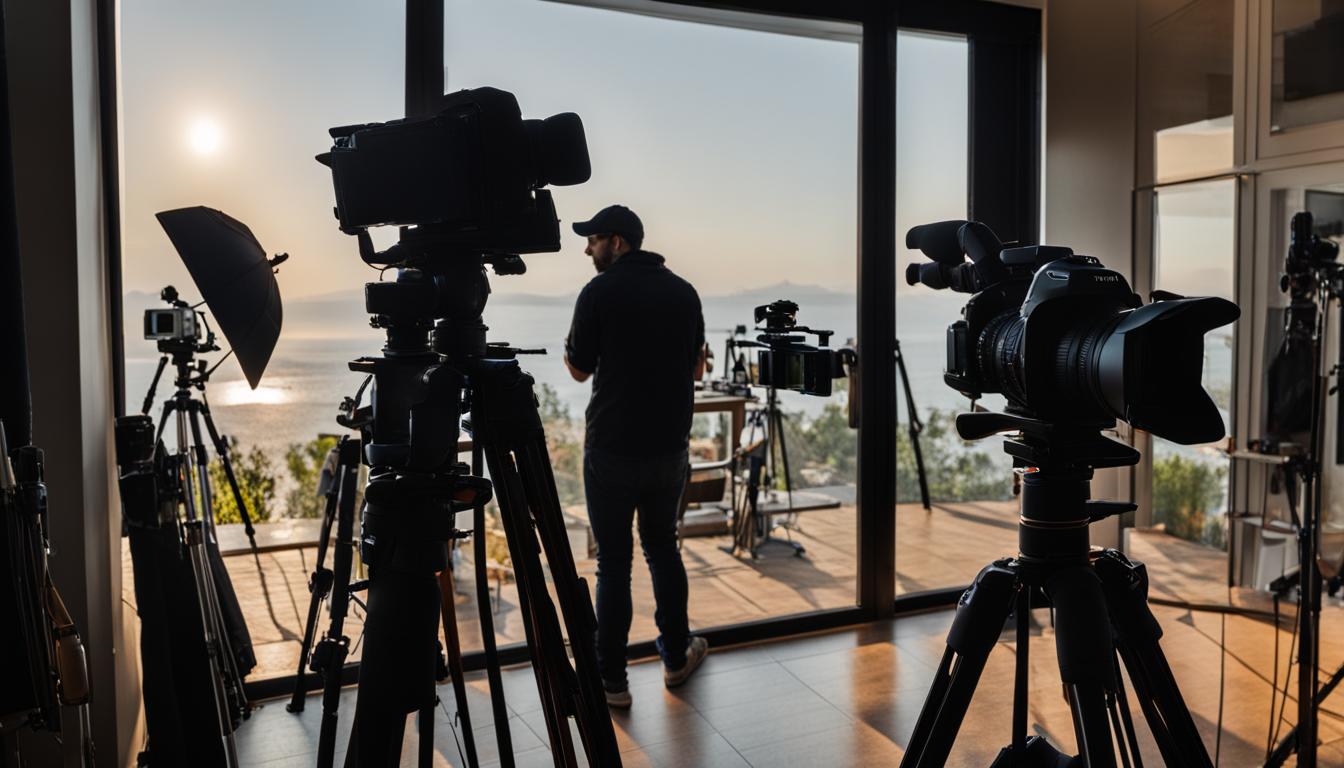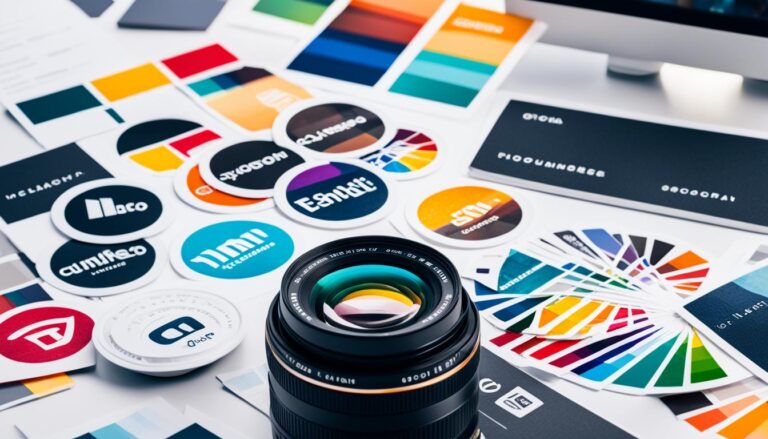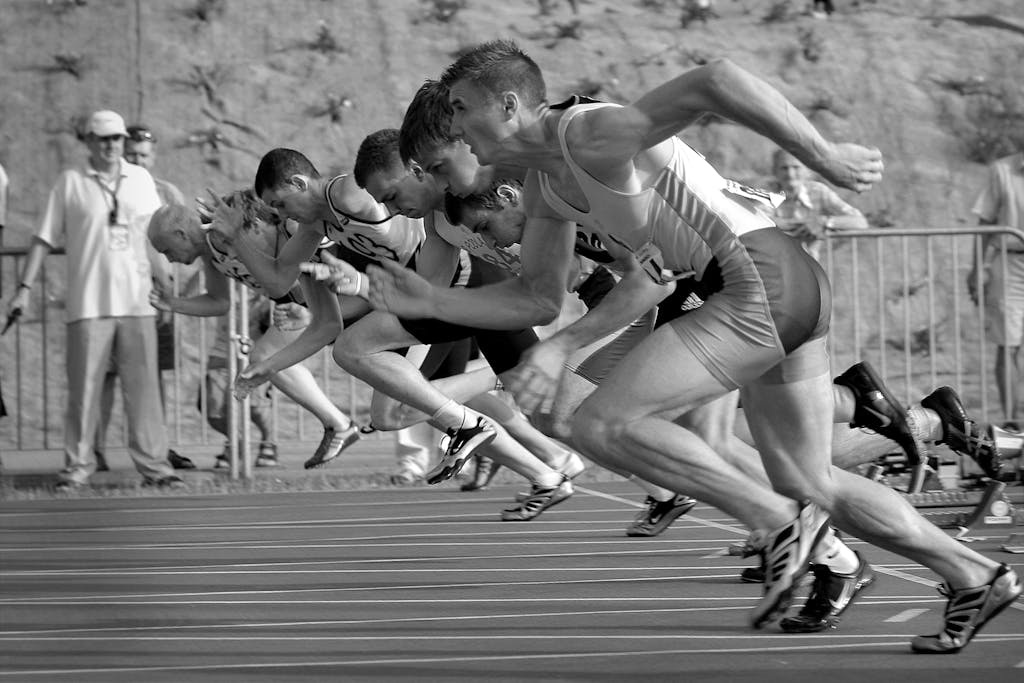How to Become a Real Estate Photographer
Have you ever marvelled at the stunning photographs of spacious homes, capturing their beauty and charm? I certainly have. There’s something about the art of real estate photography that speaks to me on a deep level. A well-composed photo can transport you into the heart of a property, evoking emotions and envisioning a lifestyle. As an avid photography enthusiast, becoming a real estate photographer allows me to blend my passion for capturing moments with my fascination for architecture and design.
If you share a similar interest and dream of a fulfilling career as a real estate photographer, you’ve come to the right place. This article will explore the steps and requirements to become a professional in this field. We will delve into the necessary skills, equipment, and techniques to succeed, equipping you with the knowledge to stand out in the competitive world of real estate photography.
So, let’s dive in and discover the path to turning your love for photography into a thriving real estate photography career.
Key takeaways:
- Real estate photography combines a passion for photography, architecture, and design.
- This article will guide you through the necessary steps to become a professional real estate photographer.
- By the end of this article, you will clearly understand the skills, equipment, and techniques required for success in this industry.
- Embrace the opportunity to showcase properties and evoke emotions through your photographs.
- Let’s embark on an exciting journey into real estate photography together.
Embarking on a Career in Real Estate Photography
In this section, we will explore the opportunities and potential of a career in real estate photography. With the steady growth of the real estate market, the demand for professional photographers who can capture the beauty and essence of properties is rising. As a real estate photographer, you can combine your passion for photography with the lucrative real estate field. Let’s take a closer look at the current market trends, the potential earnings, and the growth prospects in this industry.
Real estate photography offers a range of opportunities for photographers looking to specialize in this field. Whether you choose to work independently or collaborate with real estate agencies, there is a constant need for high-quality property images that can attract potential buyers and renters. The real estate photography market is thriving, as property owners and agents recognize the importance of captivating visuals in marketing their properties.
“In the competitive real estate market, professional photography can make all the difference. Great photos can increase property views online, generate more leads, and ultimately contribute to faster sales.” – Alex Wilson, Real Estate Agent
The potential earnings in real estate photography can be significant. Depending on factors such as location, experience, and clientele, photographers can earn a lucrative income. Real estate photographers may charge per hour, per listing, or offer packages that include services such as editing and virtual tours.
The growth prospects in the real estate photography industry are promising. As the demand for high-quality property images continues to rise, photographers who can deliver exceptional results will always be in demand. Moreover, as the real estate market expands, there are opportunities to explore different niches within the industry, such as architectural photography or luxury real estate photography.
By taking advantage of the current market trends and leveraging your photography skills, you can carve out a successful career in real estate photography. With the right combination of talent, dedication, and business acumen, you have the potential to thrive in this competitive industry and create a rewarding professional path.
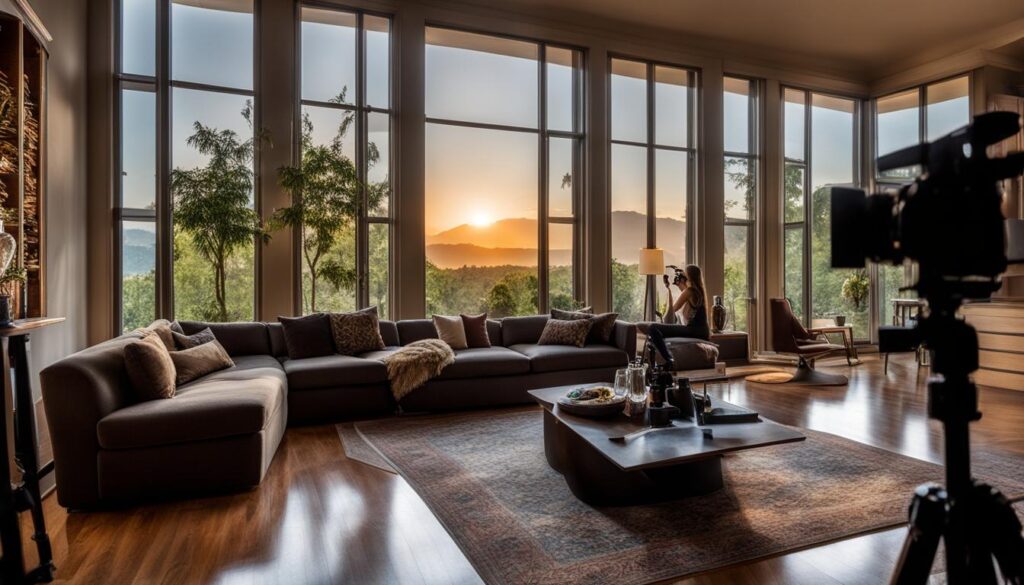
The Essential Skills for Professional Real Estate Photography
Mastering Interior and Exterior Shots
One of the most crucial skills for real estate photographers is the ability to capture stunning interior and exterior shots of properties. As a professional in this field, it’s important to showcase each space’s unique features and characteristics, immersing viewers in the beauty and atmosphere of the property.
To master interior photography, it’s essential to understand composition, staging, and utilizing the available space effectively. Pay attention to angles that highlight the room’s depth and create a sense of space. Experiment with different perspectives and focal lengths to add visual interest to your shots. Remember, the goal is to make potential buyers envision themselves living in the space.
Regarding exterior photography, focus on capturing the property’s curb appeal and unique architectural elements. Consider the time of day and weather conditions to achieve the desired lighting and mood. Experiment with different angles, heights, and lenses to find the most complementary viewpoint for showcasing the property’s exterior.
Being able to master both interior and exterior shots will ensure that you can capture the complete story of a property, enticing potential buyers and helping real estate agents effectively market the listings.
Understanding the Value of Natural and Artificial Lighting
Lighting plays a critical role in real estate photography, as it can greatly impact the overall quality of the images. Understanding how to work with natural and artificial light is essential for capturing the best photos.
In interior photography, natural light can create a warm and inviting ambience. Utilize windows and doors to let natural light pour into the space, highlighting key features and creating a bright, airy atmosphere. However, be cautious of harsh shadows and overexposure caused by direct sunlight. Consider using diffusion techniques or staging techniques, such as opening curtains or adding supplementary lighting to balance the light and shadows in the room.
When artificial lighting is necessary, ensure it complements the existing lighting in the space. Use a combination of ambient, task, and accent lighting to enhance the atmosphere and bring out the property’s best features. Experiment with different lighting setups to create an inviting and well-lit space.
Developing Efficient Editing Techniques
Editing is integral to real estate photography and can significantly enhance the final result. A skilled real estate photographer can use editing techniques to enhance the property’s features, correct imperfections, and create visually appealing images.
Incorporate basic editing techniques such as adjusting brightness, contrast, and saturation to ensure the photos are visually balanced. Pay attention to colour correction to accurately represent the property’s aesthetic. Additionally, removing distracting objects or imperfections, such as stray wires or blemishes, can greatly improve the overall appearance of the images.
Avoid over-editing, as it may lead to an unrealistic representation of the property and mislead potential buyers. Strive for a natural and authentic look while highlighting the property’s best features.

| Skills | Techniques |
|---|---|
| Mastering Interior and Exterior Shots | Understanding composition, angles, and focal lengths |
| Understanding the Value of Natural and Artificial Lighting | Utilizing natural light, balancing shadows, and using artificial lighting effectively |
| Developing Efficient Editing Techniques | Adjusting brightness, contrast, and color correction |
What Equipment Does a Real Estate Photographer Need?
It is essential to have the right equipment to capture professional real estate photos. As a real estate photographer, there are certain camera gear, lenses, tripods, and lighting equipment that you should consider investing in. These tools will enable you to capture high-quality images that showcase properties in the best possible light.
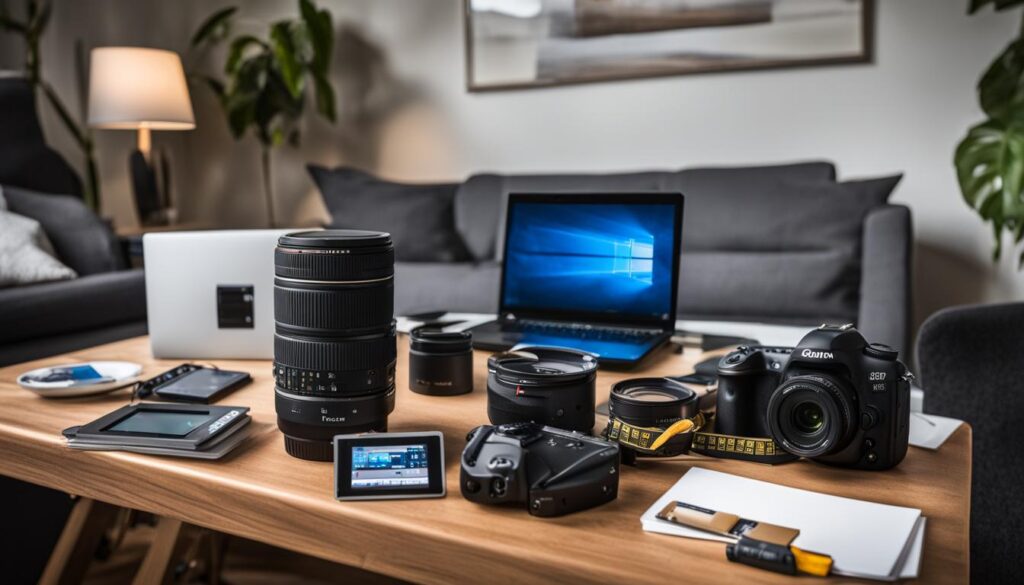
Camera Gear for Real Estate Photography
A reliable camera is one of the most crucial equipment for a real estate photographer. Investing in a digital single-lens reflex (DSLR) camera that allows for manual control over settings such as aperture, shutter speed, and ISO is recommended. This will give you greater flexibility and control when capturing different shots.
Essential Photography Equipment
In addition to a DSLR camera, there are a few other essential pieces of equipment that every real estate photographer should have:
- Wide-angle lens: Wide-angle lenses are ideal for capturing expansive interior shots and showcasing the layout of a property. They allow you to capture more of the room in a single frame, making presenting the space to potential buyers easier.
- Tripod: A tripod is crucial for maintaining stability and eliminating camera shake, especially in low-light conditions. It ensures sharp and well-focused images, particularly when shooting interiors or exteriors with long exposure times.
- External flash: An external flash can greatly improve the lighting in your photos, helping to eliminate harsh shadows and create a more balanced exposure. It is particularly useful when shooting in dimly lit spaces.
- Remote shutter release: To avoid camera shake when taking long-exposure shots or bracketed exposures, a remote shutter release allows you to trigger the camera without touching it.
- Filters: Depending on the shooting conditions, it may be beneficial to have a selection of filters, such as a polarizing filter to reduce glare and enhance colours, or a neutral density filter to reduce the scene’s brightness and achieve longer exposure times.
Investing in high-quality equipment will improve the technical aspects of your photography and give your clients confidence in your professionalism and capabilities. With the right tools, you can capture stunning images that will make properties stand out and attract potential buyers.
As a real estate photographer, it is important to regularly update and maintain your equipment to ensure optimal performance. Remember that technology advances rapidly in the photography industry, so staying up to date with the latest gear can give you a competitive edge. With a comprehensive set of equipment, you will be well-equipped to start your real estate photography business and deliver exceptional results to your clients.
Building a Compelling Portfolio as a Real Estate Photographer
As a real estate photographer, building a compelling portfolio is crucial to showcasing your skills and attracting potential clients. Your portfolio is a visual representation of your work and serves as a powerful marketing tool. Here are some key elements to consider when creating your real estate photography portfolio:
- High-Quality Real Estate Photos: Select your best real estate photos demonstrating your ability to capture properties in their best light. Choose images that showcase your composition skills, attention to detail, and ability to capture the unique features of each property.
- Organized and User-Friendly Layout: Structure your portfolio in a logical and easy-to-navigate manner. Group similar types of properties together, such as residential, commercial, or luxury properties. Use clear headings and labels to make it easy for potential clients to find what they want.
- Showcase a Variety of Properties: Display a range of property types to demonstrate your versatility as a real estate photographer. Include images of residential homes, apartments, commercial buildings, and any other properties you have photographed. This shows potential clients that you are experienced in capturing various properties.
- Before and After Edits: If applicable, include a section that showcases the difference between the original photo and your edited version. This demonstrates your post-processing skills and the value you can add to the final real estate images.
Remember to focus on quality over quantity when creating your real estate photography portfolio. Select a few of your best images to showcase your skills and expertise. Each photo in your portfolio should serve a purpose and provide a strong example of your capabilities as a real estate photographer.
To attract potential clients through your portfolio, consider the following strategies:
- Online Presence: Build a professional website or use online platforms dedicated to photographers to showcase your real estate photography portfolio. This allows potential clients to easily view and access your work.
- Client Testimonials: Incorporate client testimonials or reviews alongside your portfolio to showcase clients’ positive experiences with your services.
- Social Media Promotion: Share your real estate photography portfolio on social media platforms to expand your reach and attract potential clients.
By implementing these tips and strategies, you can create a compelling real estate photography portfolio that effectively highlights your skills and attracts clients in the competitive industry.
Setting Your Real Estate Photography Pricing
To thrive as a real estate photographer, it is essential to establish the right pricing for your services. Determining photography rates can be a complex process, but by considering key factors such as property sizes, time of day for shoots, and high-end listings, you can develop a pricing strategy that is effective and competitive in the real estate photography market.
Tailoring Prices to Property Sizes
One important aspect of setting your photography rates is considering the size of the properties you will be shooting. Larger properties may require additional time and effort to capture all the necessary shots, which can justify higher pricing. On the other hand, smaller properties may require less time and effort, allowing you to offer more competitive rates. It is crucial to tailor your prices accordingly to ensure fairness for you and your clients.
Considerations for Time of Day and High-End Listings
Another factor to consider when establishing your photography rates is the time of day for shoots and the presence of high-end listings. Certain times of day, such as golden hour or twilight, can offer unique lighting opportunities that greatly enhance the quality of your photos. Clients may be willing to pay a premium for shoots during these desirable times. Additionally, high-end listings that require extra attention to detail and luxurious presentation may justify higher rates.
You can confidently price your services by understanding the value of specialized shoots and the additional efforts required. This not only ensures fair compensation for your expertise and time but also attracts clients who recognize and appreciate the quality you provide.

Collaborating with Real Estate Agents and Clients
To succeed as a real estate photographer, it is crucial to establish strong and collaborative relationships with real estate agents and clients. Building professional connections and understanding their needs are key factors contributing to repeat business and referrals. Here are some strategies for fostering professional relationships and effective client communication:
Fostering Professional Relationships
Developing a network of real estate agents and clients is essential for a successful career in real estate photography. Building trust and rapport with them can lead to ongoing collaborations and a steady stream of projects. Here are some tips for nurturing professional relationships:
- Attend local real estate networking events and industry conferences to connect with potential clients.
- Establish a professional online presence through a website and social media platforms, showcasing your work and expertise.
- Provide excellent customer service and high-quality results to build a reputation as a trustworthy photographer.
- Maintain regular communication with real estate agents and clients, informing them about project updates and offering assistance whenever needed.
Understanding Client Needs and Turnaround Times
Effective communication with clients is essential to understand their requirements and deliver satisfactory results. Here are some ways to ensure you meet their needs and turnaround times:
- Conduct a thorough consultation with clients to understand their vision, property features, and specific photography requirements.
- Ask detailed questions to clarify any uncertainties and gather all the necessary information for a successful shoot.
- Communicate your availability and discuss realistic timelines for photo delivery.
- Ensure prompt and clear communication throughout the project, promptly addressing any concerns or questions from clients.

| Benefits of Collaborating with Real Estate Agents and Clients | Importance of Client Communication | Building Professional Relationships |
|---|---|---|
|
|
|
Exploring Advanced Real Estate Photography Techniques
In this section, we will explore advanced techniques in real estate photography. By incorporating these innovative and creative approaches, you can capture unique and captivating real estate photos that stand out from the competition.
“Creativity is allowing yourself to make mistakes. Art is knowing which ones to keep.” – Scott Adams
Regarding real estate photography, thinking outside the box can produce impressive results. Here are some advanced techniques to add flair and creativity to your photography:
- Enhanced Lighting: Experiment with different lighting techniques to create a dramatic effect. Play with shadows and highlights to bring out the architectural features of a property.
- Perspective Distortion: Use wide-angle lenses to create a unique perspective and emphasize depth in your photos. This technique can make smaller spaces appear larger and more inviting.
- Aerial Photography: Consider using drones to capture stunning aerial shots of properties. Aerial photography lets you showcase the surrounding area and provide a comprehensive property view.
- Long Exposure: Use long exposure techniques to capture the beauty of twilight or create mesmerizing light trails from moving vehicles. This can add a magical touch to your real estate photos.
- Virtual Staging: Use virtual staging software to digitally furnish and decorate vacant spaces. This technique is useful for showcasing a property’s potential and helping potential buyers visualize the space.
By incorporating these advanced techniques into your real estate photography, you can offer unique and creative solutions to your clients. It’s important to experiment and push the boundaries of traditional photography to elevate your work and set yourself apart.
To further inspire you, take a look at the image below showcasing an example of advanced real estate photography techniques:

| Technique | Description |
|---|---|
| Enhanced Lighting | Experiment with different lighting techniques to create dramatic effects, emphasizing architectural features. |
| Perspective Distortion | Use wide-angle lenses to create a unique perspective and add depth to your photos. |
| Aerial Photography | Capture stunning aerial shots using drones to showcase the property and its surroundings. |
| Long Exposure | Create magical light trails or capture twilight scenes using long exposure techniques. |
| Virtual Staging | Digitally furnish and decorate vacant spaces to showcase their potential. |
By mastering these advanced real estate photography techniques, you can take your skills to the next level and offer unique and creative solutions to your clients.
Marketing Your Real Estate Photography Business
Now that you’ve honed your skills as a real estate photographer, it’s time to focus on marketing strategies to promote your business and attract clients. Effective marketing is crucial for establishing your brand and generating a steady stream of clients in the competitive photography industry. In this section, I will discuss various online marketing techniques, social media strategies, and other promotional methods to help you succeed in marketing your real estate photography business.
One of the most powerful marketing tools for photographers is online marketing. With most potential clients searching for services online, it’s important to establish a strong online presence. Create a professional website showcasing your portfolio, services, and contact information. Optimize your website with relevant keywords such as “marketing strategies for real estate photographers” and “promoting photography business” to improve your search engine rankings.
Utilizing social media platforms is another effective way to market your photography business. Create business profiles on popular social media platforms like Instagram, Facebook, and Pinterest to showcase your work and interact with potential clients. Regularly post high-quality images and engage with your audience by responding to comments and messages.
In addition to online marketing, consider offline promotional methods as well. Attend local networking events, join photography associations, and collaborate with real estate agents to expand your network and reach potential clients. Additionally, consider offering special promotions or referral incentives to encourage word-of-mouth marketing.
Now, let’s take a look at a visually engaging and informative table summarizing the key marketing strategies for real estate photographers:
| Marketing Strategy | Description |
|---|---|
| Online Marketing | Utilize search engine optimization, create a professional website, and optimize your online presence to attract clients searching for real estate photographers. |
| Social Media Marketing | Establish a strong presence on social media platforms by regularly posting high-quality images, engaging with your audience, and leveraging relevant hashtags. |
| Offline Promotion | Participate in local networking events, join photography associations, and collaborate with real estate agents to expand your network and generate referrals. |

By implementing these marketing strategies, you’ll be able to effectively promote your real estate photography business and attract a steady stream of clients. Remember to stay consistent, engage with your audience, and continuously refine your marketing approach to stay ahead in the competitive photography industry.
Conclusion
Throughout this article, I have provided a comprehensive overview of the steps and requirements to become a successful real estate photographer. We have explored the essential skills needed, the necessary equipment, and the techniques for capturing stunning interior and exterior shots. By mastering natural and artificial lighting, developing efficient editing techniques, and building a compelling photography portfolio, you will be able to attract potential clients and stand out in the competitive real estate photography industry.
Setting the right pricing for your services, tailored to property sizes and considering factors such as the time of day and high-end listings, will ensure that you provide value to your clients while maintaining a profitable business. Additionally, fostering professional relationships with real estate agents and clients and understanding their needs and turnaround times will lead to repeat business and referrals.
By exploring advanced real estate photography techniques and leveraging marketing strategies, such as online marketing and social media promotion, you can further differentiate yourself and generate a steady stream of clients. Remember, becoming a real estate photographer is a rewarding journey that requires dedication, continuous learning, and a passion for capturing the essence of properties.
FAQ’S
Q: How can I get into real estate photography?
A: To become a real estate photographer, you can start by building a strong portfolio of your work, networking with real estate agents, and investing in the right photography gear.
Q: What type of photography gear do I need to become a real estate photographer?
A: As a real estate photographer, you will need a good camera body, wide-angle lens, tripod, external flash, editing software like Lightroom or Photoshop, and a drone for aerial shots.
Q: How do I attract real estate photography clients?
A: You can attract real estate photography clients by creating an online portfolio showcasing your work, offering competitive pricing, and providing excellent customer service to real estate agents and property owners.
Q: What are some tips for shooting real estate photos?
A: When shooting real estate photos, make sure to focus on capturing the best features of the property, use natural light whenever possible, keep the space clutter-free, and pay attention to angles and composition.
Q: Is it necessary to edit photos for real estate photography?
A: Yes, editing photos is essential in real estate photography to enhance the overall look of the property, correct lighting and colours, and make the images more appealing to potential buyers.
Q: What are some key considerations when working as a real estate photographer?
A: When working as a real estate photographer, it is important to communicate effectively with clients, be detail-oriented, deliver professional work in a timely manner, and continually improve your photography skills.
Q: Which camera is best for real estate photography?
A: The best camera for real estate photography is typically a DSLR or mirrorless camera with a high-resolution sensor, good low-light performance, and the ability to capture wide-angle shots effectively.


